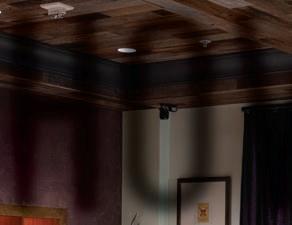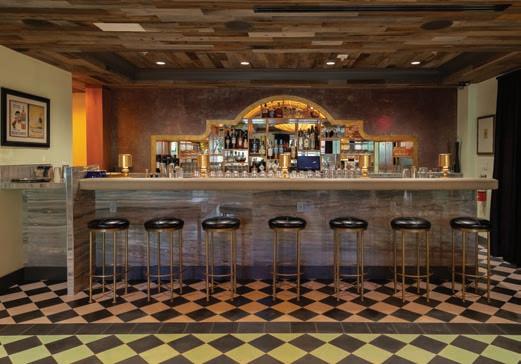
9 minute read
Pushing the Limits
HOW TO: FOOD TRENDS HOW TO

Advertisement


The Club Room proves why size doesn’t matter.
Campiello, a 21-year-old Italian restaurant in Naples, Florida, is well known for its refined eats and vast wine list. But it was the addition of a 2000-square-foot space called The Club Room at the start of 2020 that made a big splash.
“The Club Room offered us the opportunity to provide a totally distinct dining/entertainment experience for our guests while creating a space for private events and additional indoor seating during the rainy season,” says Richard D’Amico, D’Amico & Partners co-owner and founding partner. “Also, Campiello is regularly sold out in season and on the weekends year-round, so the Club Room allows us to capture customers we would otherwise lose. It also fills a niche in the Naples market, in terms of it offering an elevated level of Italian cuisine—‘Alta Cucina’—and a live music element, both combining to create an otherworldly experience.”
BY ASHLEY BRAY
The Club Room’s distinct design identity not only differentiates it from the rest of Campiello, but also from the rest of the Naples market. “The overreaching design goal was to create a look that could lead guests to think that they could be in New York City, Paris, London, or Berlin,” says D’Amico. “The Club Room really does take one away.”
The Club Room features a checkerpatterned floor tile in soft foam green and black in the dining room, and pink and black in the bar. The walls are finished in a combination of eggplant Venetian plaster and moss, accented by gold leaf trim and light green chalk paint, while the ceilings are composed of reclaimed barn siding. Finishing touches include oversized, amorphous silk pendants and elegant leather furnishings. A fireplace and a specially commissioned work of art highlight a lounge seating area located in the center of the room.
The most interesting element of The Club Room—especially for those in the industry—may be its 16-foot long bar with just eight stools and a total area of 190 square feet. “The size of the bar complements the size and look of the room and adds to the cozy feel of the space,” explains D’Amico.
However, it took some ingenuity to create a design specifically outfitted for a bar of this size that was efficient, able to provide high-volume service in a small space, and didn’t impact service to guests.
Pro Tip
When building out your setup behind the bar, bring in the staff that will actually be using it for input to test out ideas.

A fireplace and a specially commissioned work of art highlight a lounge seating area located in the center of The Club Room’s dining room.





Ross Kupitz, D’Amico & Partners fullservice restaurant’s beverage director, along with his bar staff, were the ones who actually developed the design for behind the bar. They then brought their concept to the restaurant’s design team to make it a reality.
A key part of the bar’s design is the use of custom Perlick Tobin Ellis Signature Cocktail Stations. “I first saw these cocktail ‘stations’ at Tales of the Cocktail in New Orleans in 2016, and I was very excited to see if it was something we could implement for The Club Room,” says Kupitz.
The specially designed cocktail stations feature curved bottle wells that allow bartenders to be closer to the bar top. The curved wells also allow for more bottles to be stored, which helps with faster service.
“Other station features include the bar tools storage area with constant running water (like the small sink at an ice cream shop to keep the scoop clean), foot pedal faucets, and a glass rinser,” says Kupitz. “These tools enable our bar staff to keep all of their tools (mixing glasses and shaker tins, bar spoons, muddlers, double strainers, Hawthorne and Julep strainers, vegetable peelers, channel knife) clean and ready for action.”
Kupitz says his favorite “toy” behind the bar is the refrigerated unit with a worktop. “This unit is similar to what you’d see in a kitchen for storing prepped food ingredients. The top drawer is filled with eight nine-pans that house garnishes—cold garnishes make for better drinks!” he says. “With the current menu, the garnish drawer is filled with lime, lemon, orange, grapefruit, olives, fresh mint, raw ginger, and Luxardo Maraschino cherries. The bottom drawer is deeper and used for bottle storage. It can be a convenient place for white wines served by the glass, but for our purposes, we use it to store vermouths, aromatized wines, and Cart del Salone food pairings. Keeping these beverage items cold helps them last longer and maintains flavor consistency.
“The top of this unit is a recessed drain board for glassware storage and a cutting board. It’s awesome to have this area for garnish prep, Cocktail Per Due production, and simply a nice space for making special garnishes to order.”
Cocktail Per Due (cocktail for two) and Cart del Salone are a specially presented tableside cocktail and a tableside cart program, respectively.
Cocktail Per Due is served in a porthole vessel designed by Martin Kastner of Crucial Detail (originally a custom piece for The Aviary in Chicago). It’s available in two options: the Grove & Garden Mule or a rotating recipe that is verbalized to guests each night.
“The rotating infusion gives our bar staff a creative outlet to try new flavors,” says Kupitz. “The Grove & Garden Mule porthole has fresh ginger, lemon, lemon zest, thyme, honey grappa, and vodka all steeping together inside the porthole for a minimum of five hours and up to 24 hours. We are still experimenting with recipes but have found this time range does not drastically change the flavor profile and keeps the consistency for repeat guests.”
The solid ingredients are arranged in an artistic way inside the porthole and then the liquid is added. When the Grove
QUALITY SPIRIT EVERY QUALITY COCKTAIL Deserves A


CAPE GIN • The Rooibos Tea Bush is native to the mountains of the Cedarburg Wilderness,
Western Cape South Africa. • The leaves are bruised, fermented, air dried. The botanicals of cassia and cubeb pepper frame the character of our gin.
EARL GRAY GIN • A contemporary gin where the juniper is second in character to the tea. • 10 botanicals to achieve aroma, flavor, balance and stability. contemporary where the is second character to the tea. botanicals to achieve aroma, balance stability.
CARAVAN GIN • Caravan Tea is dried over burning pine needles and evokes notes akin to smoke-peated whisky. • The botanicals of cardamom & long pepper carefully frame the character of our gin with a titillating smoke note.

BOURBON - HI-RYE, 4 GRAIN • 100% local grain to the still; distilled and aged on site in Indiana • Unique for MGP is the 4 grain bourbon, the corn and rye provide the backbone, the wheat uplifts both aroma & flavor, and the barley harmonizes the three. • Straight Bourbon Whiskey, straight from the barrel. No charcoal or cold filtration. flavor, three.


The bar in The Club Room measures just 16 feet long with a total area of 190 square feet.

& Garden Mule is ordered, the bartender gives the server a full porthole, two Mule mugs filled with ice and lime, and a bottle of ginger beer. At the guest table, the server pours the porthole liquid into the mugs and tops it with the ginger beer. The presentation is changed to fit the style of each recipe. Guests also have the option to purchase a new porthole.
“The idea behind our use of the portholes is to present a cocktail for two in an unexpected way,” says Kupitz. “It’s a great


The Club Room introduced a live music element into Campiello with nightly jazz music.

way to pique guests’ interest in a novel item and engage them in conversations about our bar program.”
The Cart del Salone offers a number of beverage and snack pairings for an after-dinner beverage/disgestive. Its current rotating offerings include pairings like Brenne six-year single malt French whiskey paired with candied pecan dipped in chocolate with sea salt, and Whistle Pig 10-year rye whiskey paired with 64% cocoa chocolate with olive oil.
“The cart service did pose some initial service challenges— how many selections are offered and where are they stored, where are the food pairings stored, glassware needed to be on the cart, etc.,” says Kupitz. “We settled on offering a rotating selection of four items per night. The four bottles are stored inside the cart along with the glassware, the small presentation plates for the food pairing, and the food items with tongs for service to the guest.
“Once the service staff got comfortable with this new type of service, the products, and how to present and sell them, the Cart del Salone has been amazing!”
Like many other venues, Campiello and The Club Room were closed due to COVID-19, with Campiello offering a to-go menu. On May 8, Campiello reopened for dine-in service in its dining room and on the patio. “Social distancing is maintained per the guidelines of the CDC, and the dining room layout has been reconfigured in keeping with the reopening rules of the state,” says Michael Smith, full service director of operations, D’Amico & Partners.
Additional cleaning and sanitizing procedures were implemented beyond the usual health requirements and between seatings. “The restaurant is continually sanitized and cleaned throughout service, tables and chairs are disinfected thoroughly after every guest, and the entire interior and exterior is professionally sanitized on a nightly basis,” says Smith.
Employees are also being scanned for signs of illness. “Managers are using surface temperature devices to scan all D’Amico restaurant employees for fever symptoms when they report for work,” says Smith. “Visual scans for illness symptoms (e.g. runny nose, cough) are being conducted. If employees display any illness symptoms, they will be sent home.”










